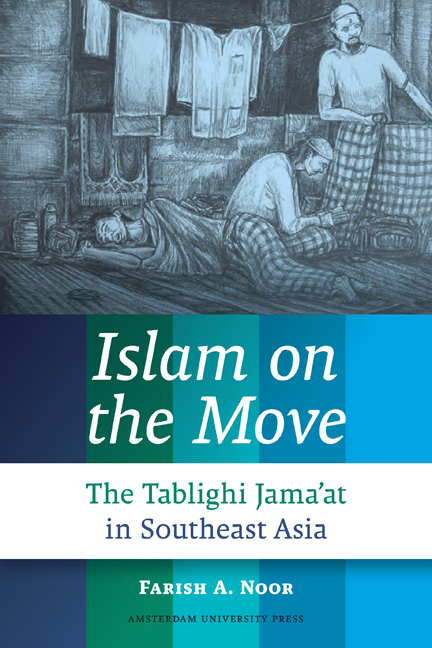Book contents
- Frontmatter
- Dedication
- Contents
- A Note on Proper Names and the Spelling Used in This Book
- Glossary
- Introduction: Brother Bismillah and My Introduction to the Tablighi Jama’at
- I At Home Across the Sea: The Arrival of the Tablighi Jama’at and Its Spread Across Southeast Asia
- II Learning to Be: The Foundational Literature of the Tablighi Jama’at and Its Role in Defining the Movement
- III Learning on the March: The Portable, Reader-friendly Literature of the Tablighi Jama’at and Its Role in the Self-identification and Reproduction of the Movement
- IV The Stories We Tell: The Conversion Narratives of the Tablighi Jama’at and the Internalisation of Tablighi Identity
- V Learning to Be Tablighi: The Rule-governed World of the Tablighi and the Disciplining of the Self
- VI How We Look and What We Are: The Tablighi Jama’at Framed in the Eyes of Others
- VII Finally, a Summing Up: The Tablighi Jama’at as the Complex Thing That It Is
- Notes
- Bibliography
- Index
I - At Home Across the Sea: The Arrival of the Tablighi Jama’at and Its Spread Across Southeast Asia
Published online by Cambridge University Press: 14 January 2021
- Frontmatter
- Dedication
- Contents
- A Note on Proper Names and the Spelling Used in This Book
- Glossary
- Introduction: Brother Bismillah and My Introduction to the Tablighi Jama’at
- I At Home Across the Sea: The Arrival of the Tablighi Jama’at and Its Spread Across Southeast Asia
- II Learning to Be: The Foundational Literature of the Tablighi Jama’at and Its Role in Defining the Movement
- III Learning on the March: The Portable, Reader-friendly Literature of the Tablighi Jama’at and Its Role in the Self-identification and Reproduction of the Movement
- IV The Stories We Tell: The Conversion Narratives of the Tablighi Jama’at and the Internalisation of Tablighi Identity
- V Learning to Be Tablighi: The Rule-governed World of the Tablighi and the Disciplining of the Self
- VI How We Look and What We Are: The Tablighi Jama’at Framed in the Eyes of Others
- VII Finally, a Summing Up: The Tablighi Jama’at as the Complex Thing That It Is
- Notes
- Bibliography
- Index
Summary
Men make history, and the leading members of the revolutionary generation realised that they were doing so, but they could never have known the history they were making … What in retrospect has the look of a fore-ordained unfolding of God's will was in reality an improvisational affair in which sheer chance, pure luck – both good and bad – and specific decisions made in the crucible of political crises determined the outcome … If hindsight enhances our appreciation for the solidity and stability of the (historical) legacy, it also blinds us to the stunning improbability of the achievement itself.
Joseph J. EllisMuslims have feet, and tend to move about like everybody else.
The history of Islam and Muslim society can be read as a history of movement, for without such movement Islam would not be the global religion that it is today. For centuries, Muslims have travelled across the world for the sake of commerce, politics, diplomacy, warfare and to spread Islam as well. The Muslims that I am concerned with in this book are the members of the Tablighi Jama’at, a global movement of itinerant lay Muslim missionaries that has been described by scholars like Masud, Metcalf, Sikand and Reetz as a global pietist movement for faith renewal among Muslims, and which may well be one of the biggest missionary movements of any religion in the world today.
The origins of the Tablighi Jama’at go back to Mewat, North India and the Deobandi tradition that originated from the Dar’ul Uloom madrasah in Deoband, Uttar Pradesh. The Deobandi movement was started by Muhammad Qassim Nanotawi and Maulana Rashid Ahmad Gangohi in 1867. Like the Deobandis, the Tablighis were conservative fundamentalists who were inspired by the reformists of the Salafi movement from the Arab lands. However, unlike the Deobandis who were educationists, the Tablighis were mainly lay missionaries who sought to transform Muslim society and bring Muslims back to the path of true Islam.
The Tablighi movement was formed around 1926-27 by Muhammad Ilyas Kandhalawi (1885-1944), whose family was closely linked to the Deobandi leadership and its sister school, the Mazahiru’l-Ulum in Saharanpur. Ilyas was known for both his knowledge of Islam and his Sufi inclinations, and his work was later continued by his successors, Yusuf Kandhalawi (1917-1965) and Muhammad Zakaria Kandhalawi (1898-1982).
- Type
- Chapter
- Information
- Islam on the MoveThe Tablighi Jama'at in Southeast Asia, pp. 27 - 62Publisher: Amsterdam University PressPrint publication year: 2013



